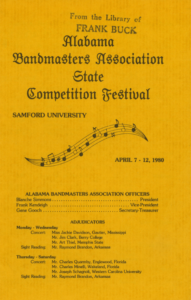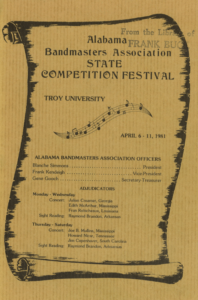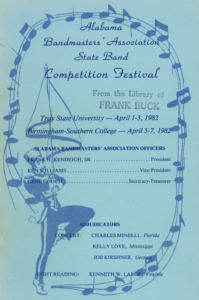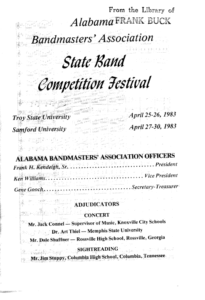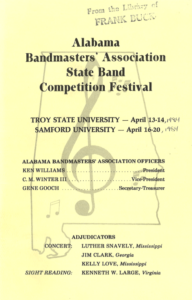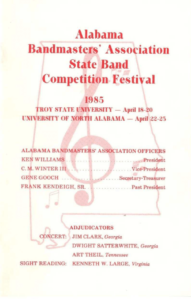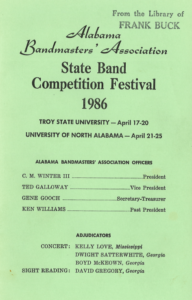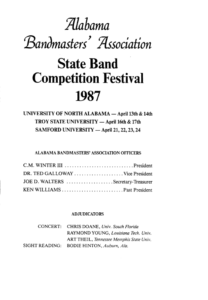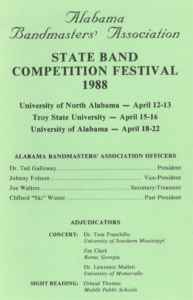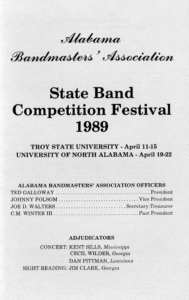1940‘s – 1950‘s – 1960‘s – 1970‘s – 1980‘s – 1990‘s – 2000‘s – 2010‘s – 2020‘s
The 1980s was a decade that saw growth and division. The “state” event started to divide into multiple locations. All-State divided into separate events from band, orchestra, and chorus. That move allowed the All-State concerts for each division to expand to more groups and longer programs.
Enjoy this portion of the story of Alabama’s school band movement and the members of the Phi Beta Mu Hall of Fame who helped shape it.
Click the year or the program cover to open a PDF of the printed program.
1980
One of the long-standing traditions of this event is that bands play in the order of classification. Adjudicators hear all Class F bands back-to-back, followed by Class E, Class EE, etc. The event would conclude with Class AA bands one after the other. The only exception would be that the director serving as administrator for the competition-festival, typically the ABA President, would perform early. This practice would allow the director to focus on the administration of the event. That tradition continues this year, but it will only last for one year more.
A total of 80 bands participated in this year’s event, quite a drop from previous participation.
Until now, the Alabama All-State Festival included band, orchestra, and chorus. Beginning this year, the Alabama Vocal Association held its own All-State Festival.
1981
The Alabama Bandmasters Association State Competition Festival relocated this year to Troy University (then known as Troy State University).
Seventy-eight bands participated. The new location, being in the southern part of the state rather than in Birmingham, could be seen as a cause for many northern Alabama bands not participating.
As we look at the movement from a state event to eight district-level events, this change in location and a second year of low participation is a precursor to another large change next year.
1982
For the first time, the Alabama Bandmasters Association State Competition Festival was held in two locations. Troy remained one of the two. Birmingham Southern College was the other. The change lessened the travel time for many bands. Directors could choose either location. Just over 100 bands participated, a return to pre-1980 levels.
A notable change was the order in which bands played. Rather than all Class F bands performing back-to-back, classifications were built each day. Each day would start with middle school, build through smaller high school classifications, and end with the largest schools.
Another change was that a single panel of adjudicators listened to every band. This move would ensure that even though bands of the same classification would perform on different days and in different locations, they would perform for the same panel. The obvious advantage is the consistency of ratings throughout the event.
This year, Hall of Fame member Suzanne Winter made her debut at the competition-festival with her L. M. Smith Middle School band.
1983
This year, Hall of Fame member Curtis Burttram made his debut at the competition-festival with his Douglas High School band.
Troy and Samford served as hosts for this year’s event. Participation grew to 114 bands.
The distribution of ratings is as follows:
- Superior 48 (42%)
- Excellent 47 (41%)
- Good 19 (17%)
- Fair 0 (0%)
This year is the first where the Alabama Orchestra Association began holding its own All-State Festival, following a move the Alabama Vocal Association made several years ago.
1984
This year’s competition-festival continued with dual sites at Troy and Samford. Starting this year, classifications were built each morning and again each afternoon. The morning would start with a Class F band and build towards Class AA. After lunch, judges would hear more Class F and build to Class AA to end the day.
The distribution of ratings of the 117 bands is as follows:
- Superior 50 (43%)
- Excellent 55 (47%)
- Good 12 (10%)
- Fair 0 (0%)
1985
This year, Hall of Fame member Steve McLendon made his debut at the competition-festival with his Fairview High School band.
The distribution of ratings of the 122 bands is as follows:
- Superior 56 (46%)
- Excellent 54 (44%)
- Good 12 (10%)
- Fair 0 (0%)
1986
The classification system expanded once again to include “Class G,” designating middle schools with two grades only. Students in this classification would generally have a year less playing experience than other middle schools. The competition-festival included only one Class G band, but this number would grow.
The distribution of ratings of the 127 bands is as follows:
- Superior 36 (28%)
- Excellent 76 (60%)
- Good 15 (12%)
- Fair 0 (0%)
This year, Hall of Fame member Garry Taylor made his debut at the competition-festival bringing two bands from Cullman High School.
1987
This year, the Alabama Bandmasters Association State Competition Festival split into three sites: Troy, the University of North Alabama, and a return to Samford University.
The distribution of ratings of the 113 bands is as follows:
- Superior 30 (27%)
- Excellent 58 (51%)
- Good 22 (19%)
- Fair 3 (3%)
1988
This year’s competition-festival was held in three sites: Troy, North Alabama, and a return to the University of Alabama. Judging in Tuscaloosa lasted five days. The other two sites ran for two days each.
The same panel of judges has listened to every band throughout the state. This practice began in 1978 when the event first moved away from the University of Alabama. This year’s This year, the judges were away from their own institutions for nine days.
The distribution of ratings of the 110 bands was far more lenient than in preceding years:
- Superior 68 (62%)
- Excellent 38 (34%)
- Good 4 (4%)
- Fair 0 (0%)
1989
This year’s festival returned to two sites: Troy and the University of North Alabama.
The distribution of ratings of the 124 bands represented a “happy medium” between the distributions of the previous two years:
- Superior 55 (44%)
- Excellent 60 (49%)
- Good 9 (7%)
- Fair 0 (0%)
The Alabama All-State Festival expanded this year. Joining the Red, White, and Blue Band was the All-State Junior High Band.
